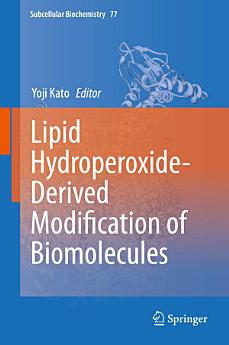Lipid Hydroperoxide-Derived Modification of Biomolecules
Yoji Kato
Des 2013 · Subcellular Biochemistry Buku 77 · Springer Science & Business Media
eBook
202
Halaman
reportRating dan ulasan tidak diverifikasi Pelajari Lebih Lanjut
Tentang eBook ini
Lipid peroxidation is an important cellular process which can lead to detrimental effects if it is not regulated efficiently. Lipid hydroperoxide is formed in an initial step of lipid peroxidation. Lipid hydroperoxide is also known as a potential source of singlet oxygen. Harmful aldehydes are formed when the lipid hydroperoxide is degraded. The formed aldehyde has high reactivity against thiol or amine moieties. Therefore, it could act as a signaling molecule, which might induce the changing of gears inside a cell. Recent studies have shown that lipid hydroperoxide or a slightly modified product of the lipid hydroperoxide reacts with biomolecules such as proteins and aminophospholipids, which leads to formation of amide-type adducts. Amide-type adducts could be one of markers for oxidative stress and could also be an important player in some diseases. In this book, the chemistry and biochemistry of lipid hydroperoxide along with their conjugates with biomolecules are described.
Beri rating eBook ini
Sampaikan pendapat Anda.
Informasi bacaan
Smartphone dan tablet
Instal aplikasi Google Play Buku untuk Android dan iPad/iPhone. Aplikasi akan disinkronkan secara otomatis dengan akun Anda dan dapat diakses secara online maupun offline di mana saja.
Laptop dan komputer
Anda dapat mendengarkan buku audio yang dibeli di Google Play menggunakan browser web komputer.
eReader dan perangkat lainnya
Untuk membaca di perangkat e-ink seperti Kobo eReaders, Anda perlu mendownload file dan mentransfernya ke perangkat Anda. Ikuti petunjuk Pusat bantuan yang mendetail untuk mentransfer file ke eReaders yang didukung.







